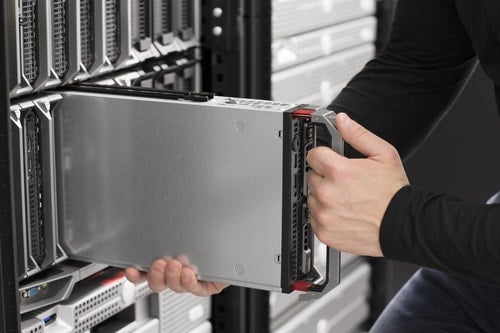Mainframes aren’t going away. Despite the rise of cloud, the forthcoming promise of quantum and the mass-scale ubiquity of datacenter operations capabilities, the installed base of mainframe applications out there—largely serving the financial sector, retailers, and enterprise conglomerates as they do—appear to be something we will still be talking about for some time to come.
As IBM itself reminds us, every time you use an ATM, book an airline ticket and most times you’ve visited and paid for something in the supermarket, you have interacted with a mainframe’s computing power at some level.
There is a brain drain in terms of the skills needed to operate mainframes today. With mainframe operating systems and languages being consigned by many millennial and Generation-Z programmers as archaic relics of a bygone era, the industry has had to find new ways to access the installed base of mainframe resources giving us their high availability and breadth for high volume input/output, which still has a place.
The Ultimate Cloud Mainframe Question Is…
If so-called mainframe modernization tools exist to primarily provide access to and control of pre-existing mainframe resources, then do they fail to also provide advantages of the more granular and composable approach we take to modern technologies such as containerization, shift-left testing, Infrastructure-as-Code and the whole smorgasbord of cloud-native tooling that we now think of as state-of-the-art?
If the discussion thus far sets out something of the state of the nation, then what kind of work is going on to engineer the incumbent global estate of mainframe resources into our modern stacks?
Of recent note is the work executed by enterprise system connectivity and data management specialist Software AG. The Germany headquartered softwarehaus has joined the IBM Z and Cloud Modernization Center. Not a physical office center premises as such (although somewhat cheesily described as being a digital front door), this is an IBM service-portal cum tool training website resource designed to help firms modernize their applications, data and processes in an open hybrid cloud architecture.
Also read: Fighting API Sprawl in the Modern Cloud Maul
Open Hybrid Cloud Architecture
Those last four words were important. This is an ‘open hybrid cloud architecture’ that works to take down barriers to mainframe modernization for customers by using application programming interfaces (APIs) to connect mainframe applications to the cloud without altering any code.
Both firms insist that APIs provide a non-invasive approach to modernization by creating real-time interactions between applications distributed across on-premises and multi-cloud environments. Software AG’s API-enabling mainframe integration solutions, webMethods and CONNX, are designed to give enterprises options to create reusable services from mainframe application code, screens or data.
IBM appears to be quite comfortable with stretching the definition of hybrid multi-cloud platform deployment to also include API-connected mainframe conduits. According to a recent IBM Institute for Business Value survey known as The hybrid cloud platform advantage, “The value derived from a full hybrid, multi-cloud platform technology and operating model at scale is 2.5 times the value derived from a single platform, single cloud vendor approach. Further, an IBM hybrid cloud transformation that integrates IBM Z can extend up to 5x the value of a public cloud only approach.”
The value within here is said to not only come from system availability and transactional throughput prowess, IBM worked with strategy consulting company Hurwitz and Associates on a sponsored paper that found value derived by: business acceleration, developer productivity, infrastructure cost efficiency, regulatory, compliance and security, as well as deployment flexibility.
Also read: The Integration Chasm that is Killing Cloud
An Ability for Flexibility & Stability
General Manager for Mainframe Solutions at Software AG Arno Theiss also appears to buy the ‘hybrid means mainframe too’ argument. Theiss insists that companies need the flexibility of the cloud for some applications and platforms, combined with the stability and ownership of an on-premises mainframe.
“In a truly connected enterprise, data should be able to flow in any direction between applications, regardless of where they reside. This is the only way to deliver connected services to customers and make business operations more efficient. We will help IBM Z clients build a hybrid environment using APIs around their mainframes so it can connect to the cloud in a non-invasive way and address the risk of disrupting their core applications,” Theiss says.
Inside the IBM Z and Cloud Modernization Center the company promises to bring together tools, training workshops, global systems integrators and technology partners to create and execute a roadmap that is engineered to lower risk and maximize business value.
Big Blue refers to the complete service as an “interactive digital journey”, which showcases comprehensive access to resources, capabilities and guidance for business professionals, IT executives, and developers alike. Through the Center, customers will gain access to a partner learning hub, including resources from Software AG and details about its API-enabling mainframe integration solutions.
Faced With a Choice, Take Both
Did we answer the big cloud mainframe question?
If we take Software AG’s Theiss’ words as gospel and accept that we need the cloud flexibility plus mainframe stability, then we can perhaps say yes, we still have the ability to embrace granularity and containerized composability, but with a serious side order of mainframe power as well.
The real crux of this cloud-mainframe hybrid marriage will arguably come if we can make core mainframe-side—like ‘server-side’ with deeper guts—functions available for reuse (things like payment reconciliation or other back-end core data stream functions) without all the upper tier application white noise—functions like inventory, sales, logistics etc.—which can be upwardly abstracted to more modern, typically cloud-native, environments.
After all, The Creed for the Sociopathic Obsessive-Compulsive (Peter’s Laws) is much beloved of programmer/developer software engineers of all types and it does state that when given choice, take both.
The hybrid cloud mainframe combo platter is served, so caution: filling may be hot.
Read next: Managed Cloud Services for SaaS Companies



